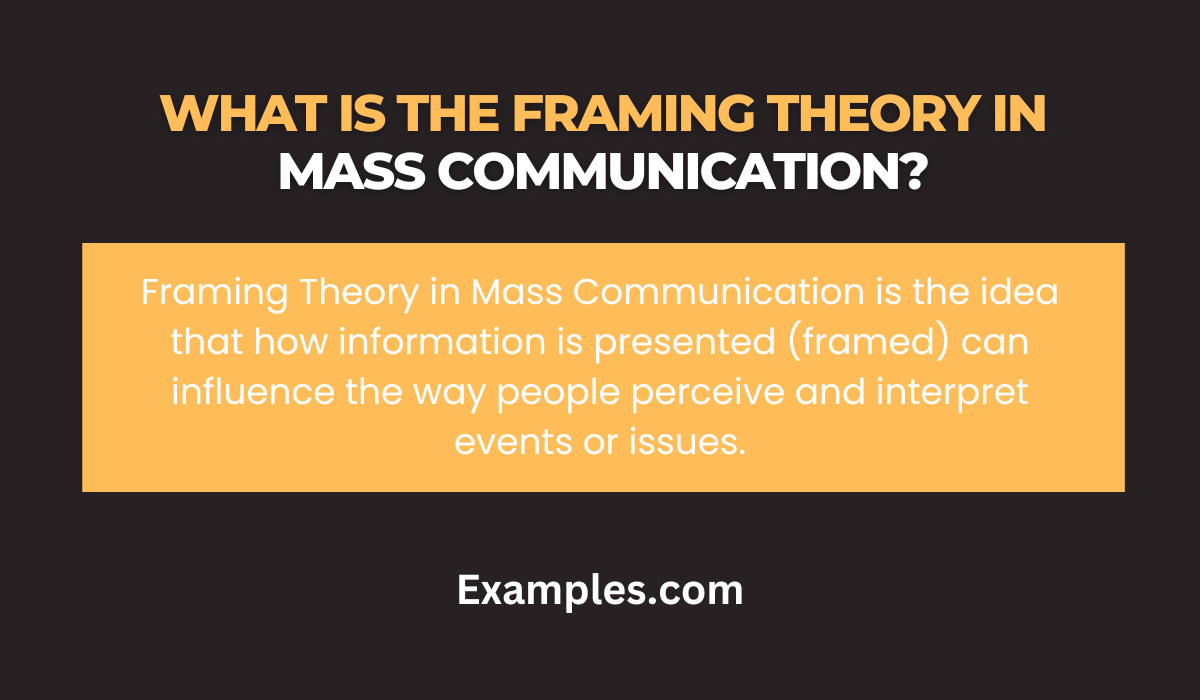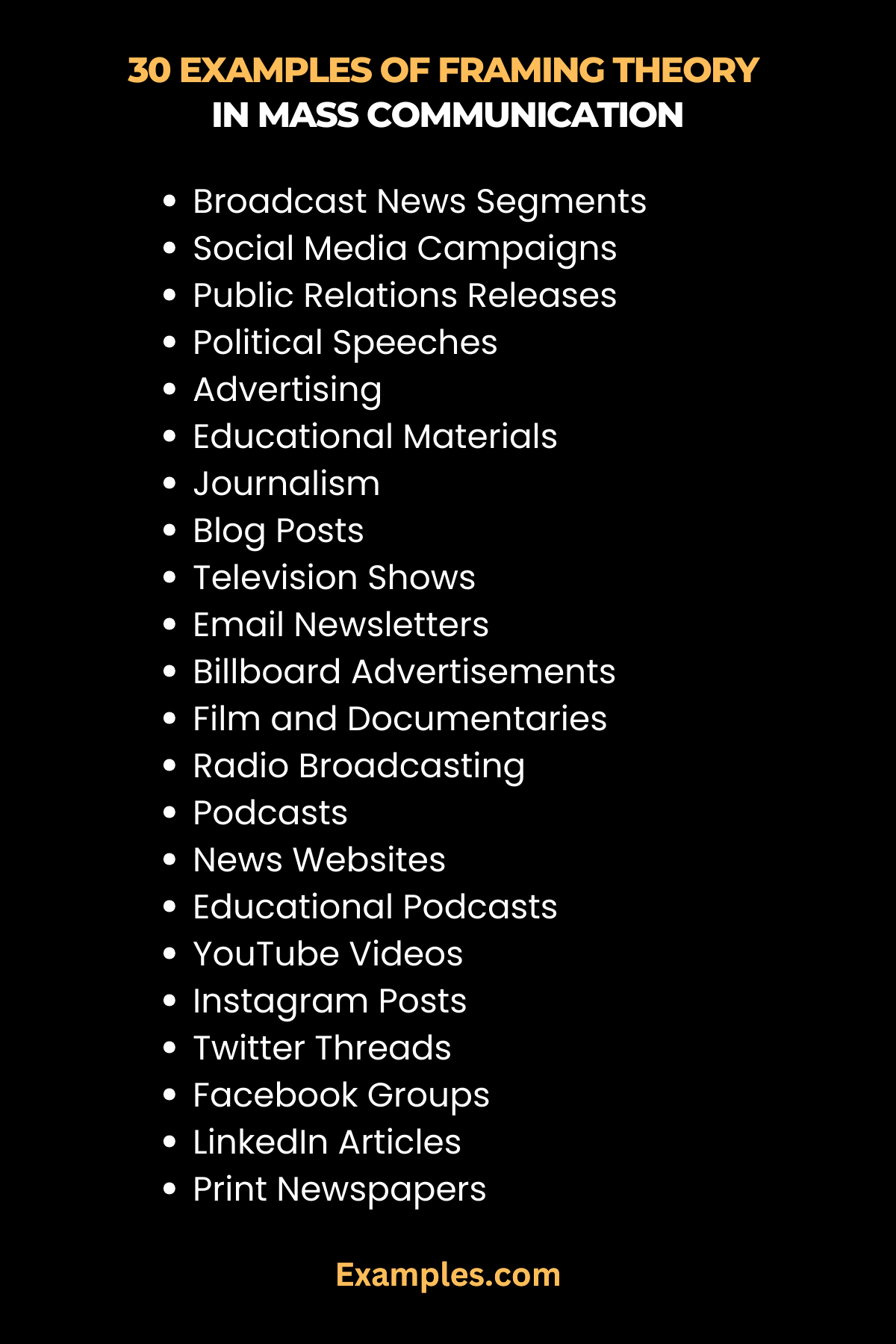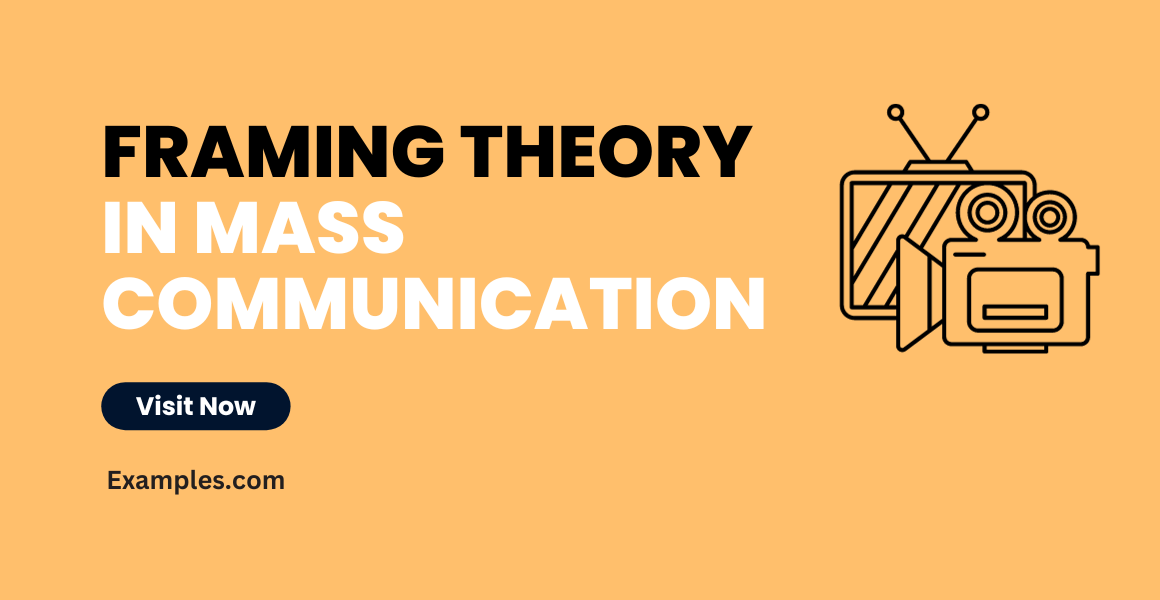29+ Framing Theory in Mass Communication Examples
Framing Theory plays a pivotal role in Mass Communication, shaping how information is presented and perceived. This comprehensive guide delves into various aspects of Mass Communication, illustrating how Framing Theory influences public opinion and social dynamics. It encompasses topics like Mass Communication Characteristics, exploring how different frames affect the interpretation of media messages. Understanding this theory is crucial in fields such as Journalism Mass Communication and Social media Mass Communication, where message construction directly impacts audience engagement and perception. This guide offers valuable insights for professionals and students alike, highlighting the theory’s relevance in contemporary media scenarios.
What is the Framing Theory in Mass Communication?
Framing Theory is a significant concept in the realm of mass communication. This theory focuses on how information is presented or “framed” in the media and how this presentation influences the perception and understanding of the audience. In essence, the Framing Theory delves into the idea that the way information is packaged or presented can significantly affect how audiences interpret and respond to that information.
Understanding Framing Theory
Framing Theory operates on the premise that media, whether it’s news, entertainment, or social media mass communication, does not simply present facts or information neutrally. Instead, media frames information in specific ways that shape and influence public opinion. These frames can be in the form of the language used, the focus or emphasis on particular aspects of a story, and even in what is included or excluded from the narrative.
For example, in a mass communication scenario, if a news story about a political event focuses heavily on the economic impacts rather than the social implications, the audience is more likely to consider the economic factors as more significant. Similarly, the tone and language used can frame a subject positively or negatively, guiding the audience towards a particular viewpoint or interpretation.
Impact of Framing Theory in Mass Communication
The Framing Theory is crucial in understanding how public opinion is shaped and how societal norms and values are constructed and reinforced. In mass communication, it plays a pivotal role in:
- Media Influence: It helps to understand the power of the media in shaping public perception and opinion.
- Public Relations and Advertising: In public relations mass communication, framing is used to create a specific image or reputation for a person, company, or product.
- Political Communication: Politicians and governments use framing to influence public opinion on policies and issues.
- Journalism and News Reporting: Journalists and news outlets use framing to highlight certain aspects of news stories, thereby influencing the audience’s understanding and interpretation.

History
Framing Theory, a significant concept in mass communication, delves into how news and media shape our perceptions by focusing on specific aspects of reality. This theory plays a pivotal role in understanding Mass Communication Examples and Mass Communication Characteristics.
Origins and Evolution
The origins of Framing Theory in mass communication can be traced back to the early 20th century, influenced by sociological and psychological perspectives. It gained prominence in the 1970s and 1980s through the works of Erving Goffman and later, through the contributions of Robert Entman. Goffman’s book “Frame Analysis” (1974) was instrumental in shaping the early conceptualization of the theory.
What is the Best Example of Framing Theory in Mass Communication?
Framing Theory is a fundamental concept in mass communication, offering a unique perspective on how media presentations can influence the audience’s perception and interpretation of information. This theory suggests that the way information is presented (or “framed”) in media can significantly impact how it is understood and processed by the audience. The emphasis of Framing Theory lies in the subtle nuances and context provided in the communication, which can shape the audience’s attitude and response to the message.
Key Aspects of Framing Theory
- Selection and Salience: Framing involves selecting certain aspects of a perceived reality and making them more salient in a communicating text. This process influences how audiences will interpret the message.
- Influence on Perception: By highlighting specific elements and angles in a story, media can shape how viewers perceive the issues. This does not mean manipulating the facts, but rather presenting them in a certain light or context.
- Real-Life Applications: In mass communication scenarios, framing is evident in news reporting, political campaigns, and advertising. For example, a news report on climate change might frame the issue as an environmental crisis or as an economic challenge, influencing public opinion and policy discussions.
- Cultural Resonance: Framing often employs culturally familiar narratives or stereotypes, making the message more relatable and persuasive to the audience.
Examples and Applications
- Journalism Mass Communication: How different news outlets report on the same event can vary significantly based on their framing.
- Advertising and Public Relations: Brands and organizations use framing to position their products or views in a favorable light.

30 Examples of Framing Theory in Mass Communication
Framing Theory in Mass Communication explores how media and communicators shape audience perceptions by presenting information in specific ways. It emphasizes the power of context and presentation in influencing audience interpretation. Framing Theory demonstrates that how something is communicated can be as impactful as what is communicated.

- Broadcast News Segments: News channels often frame stories to align with their audience’s beliefs. For example, a channel may emphasize economic aspects of a political decision, while another focuses on social impacts.
- Social Media Campaigns: A brand’s product launch on social media can be framed to highlight its environmental friendliness, appealing to eco-conscious consumers.
- Public Relations Releases: Companies use framing in press releases to highlight positive aspects and downplay negatives. For instance, framing a layoff as a ‘strategic realignment’.
- Political Speeches: Politicians frame their messages to resonate with target demographics, emphasizing issues like ‘national security’ or ‘economic growth’.
- Advertising: Commercials frame products to associate them with happiness, success, or family values, influencing consumer perception.
- Educational Materials: Textbooks can frame historical events from different perspectives, impacting students’ understanding of history.
- Journalism: Reporters’ choice of words, sources, and angles can frame a news story to convey a specific narrative or bias.
- Blog Posts: Bloggers often frame their personal stories to evoke specific emotions or responses from readers.
- Television Shows: Scripted shows can frame societal issues in a narrative, influencing public opinion subtly.
- Email Newsletters: Businesses frame content in newsletters to highlight benefits of their services or products, driving sales or engagement.
- Billboard Advertisements: Billboards often use framing to create a quick and powerful impression of a brand or product.
- Film and Documentaries: Directors frame stories to elicit specific reactions, whether to inform, entertain, or persuade.
- Radio Broadcasting: Radio segments frame information in a way that’s easy to digest for listeners, often focusing on immediate, local concerns.
- Podcasts: Podcasters frame their discussions to engage listeners, often focusing on niche topics or unique perspectives.
- News Websites: Online news platforms frame articles to cater to their specific audience demographics, often through headlines and featured images.
- Educational Podcasts: These frame complex topics in more digestible, relatable formats for easier understanding.
- YouTube Videos: Content creators frame their videos to maximize engagement, often using sensational titles or thumbnails.
- Instagram Posts: Influencers frame their posts to create desirable lifestyles or product associations.
- Twitter Threads: Users frame their opinions in threads to persuade or inform followers, often focusing on current events.
- Facebook Groups: Group admins frame discussions to foster community and shared interests.
- LinkedIn Articles: Professionals frame articles to showcase expertise or industry insights.
- Print Newspapers: Headlines and photo choices frame the day’s news, setting a tone or perspective.
- Corporate Websites: Companies frame their missions and values to attract customers and investors.
- Online Forums: Discussion framing in forums can shape collective opinions or debates.
- Viral Marketing Campaigns: These are framed to create buzz and word-of-mouth promotion.
- Health Campaigns: Framing in public health messages can influence behaviors and attitudes.
- Environmental Advocacy: Messages are framed to highlight urgency or inspire action.
- Cultural Exhibitions: Museums frame exhibits to narrate cultural or historical stories.
- Educational Seminars: Presenters frame topics to engage and educate audiences.
- Book Publishing: Publishers frame book covers and summaries to attract specific reader demographics.
Role of Framing Theory in Mass Communication
Framing Theory in mass communication highlights the power of media in shaping the perception of reality. It emphasizes how the presentation of information, particularly the focus, angle, and context, can significantly influence public understanding and response. This theory is integral to the field of mass communication for several reasons:
- Selective Emphasis: Media outlets often highlight specific aspects of a complex situation, thereby directing the audience’s attention to particular elements. This selective emphasis can shape public opinion and discourse.
- Contextualization: Framing involves providing a context to the news, which helps audiences understand and interpret information within a broader narrative.
- Influence on Public Opinion: By framing issues in a certain way, media can influence public opinion and even policy decisions.
- Agenda Setting: Framing can be seen as an extension of the agenda-setting theory, where media doesn’t just tell people what to think about but also how to think about it.
Importance of Framing Theory in Mass Communication
The importance of Framing Theory in the realm of mass communication cannot be overstated:
- Shaping Perception: It plays a critical role in shaping how audiences perceive news events and issues. The frame applied can make the same news story evoke different responses from the audience.
- Cultural and Social Impact: The theory underlines the media’s role in shaping cultural and social norms by highlighting certain values, issues, and interpretations over others.
- Political Influence: In politics, framing is crucial in influencing voter perception and opinion, often used in campaigns and policy discussions.
- Ethical Considerations: Understanding framing helps in recognizing the ethical responsibilities of journalists and media professionals to present balanced and fair perspectives.
How to use Framing Theory in Mass Communication
Applying Framing Theory in mass communication involves several strategic steps:
- Identify the Core Message: Determine the central idea or message that needs to be communicated.
- Choose a Relevant Frame: Select a frame that aligns with the message’s purpose and the audience’s values and beliefs. This could be a conflict frame, human interest frame, or economic consequences frame, among others.
- Highlight Specific Aspects: Emphasize certain elements over others to shape the audience’s perception.
- Contextualize Information: Provide context to help the audience understand the issue within a broader narrative.
- Anticipate Audience Reaction: Predict how different audiences might respond to various frames and adjust the messaging accordingly.
- Ethical Consideration: Always maintain ethical standards in framing, avoiding manipulation and ensuring a balanced presentation of information.
The Framing Theory plays a pivotal role in mass communication, influencing how information is presented and perceived. Understanding and applying this theory effectively is crucial for media professionals, especially in areas like public relations, journalism, and broadcasting.
In the dynamic landscape of Mass Communication, Framing Theory emerges as a pivotal concept, guiding how information is presented and interpreted. This theory plays a crucial role in shaping public perception and understanding, particularly in fields like journalism, broadcasting, and social media. Whether it’s through the lens of a Mass Communication Scenario or the intricate workings of media outlets, Framing Theory underlines the importance of context and perspective in communication. By acknowledging this, individuals and professionals can enhance their ability to navigate and influence the multifaceted world of Mass Communication.



